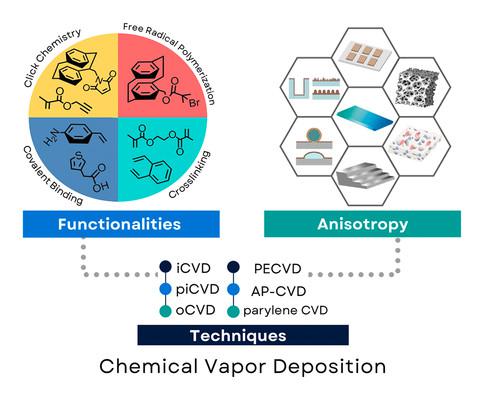Vapor-Deposited Polymer Films and Structure: Methods and Applications
引用次数: 0
Abstract
Vapor deposition of polymers is known to result in densified thin films, and recent developments have advanced these polymers with interesting fabrication techniques to a variety of controlled structures other than thin films. With the advantages of chemical modification and functionalization of these polymers, advancements have combined both the physical and chemical properties of these vapor-deposited polymers to obtain controlled anisotropic polymers, including layer-by-layer, gradient, hierarchical, porosity, and the combination of the above, meaning that the produced polymers are functional and are addressed in devised physical configurations and chemical compositions. The main purpose of using polymer coatings as a tool for surface modification is to provide additional properties that decouple the natural properties of the underlying materials (including metals, polymers, oxides/ceramics, glass, silicon, etc.), and recent advancements have rendered novel insights into combined physical and chemical properties to fulfill the increasing needs of sophisticated requirements of materials for users. The review herein intends to deliver messages of recent progress of the advancements of vapor-deposited polymers, with discussions of the variations of the physical structures and chemical functionalities, and how these two aspects are integrated with novel fabrication techniques.

气相沉积聚合物薄膜和结构:方法和应用
众所周知,聚合物的气相沉积会导致致密的薄膜,最近的发展已经用有趣的制造技术将这些聚合物推进到薄膜以外的各种受控结构。利用这些聚合物的化学改性和功能化的优势,这些进步结合了这些气相沉积聚合物的物理和化学性质,以获得可控的各向异性聚合物,包括层间、梯度、分层、孔隙度,以及上述的组合,这意味着生产的聚合物是功能性的,并在设计的物理构型和化学成分中得到解决。使用聚合物涂层作为表面改性工具的主要目的是提供额外的特性,使底层材料(包括金属、聚合物、氧化物/陶瓷、玻璃、硅等)的自然特性去耦,最近的进展使人们对综合物理和化学特性有了新的认识,以满足用户对材料日益增长的复杂要求。本文综述了气相沉积聚合物的最新进展,讨论了气相沉积聚合物的物理结构和化学功能的变化,以及如何将这两个方面与新的制造技术相结合。
本文章由计算机程序翻译,如有差异,请以英文原文为准。
求助全文
约1分钟内获得全文
求助全文

 求助内容:
求助内容: 应助结果提醒方式:
应助结果提醒方式:


